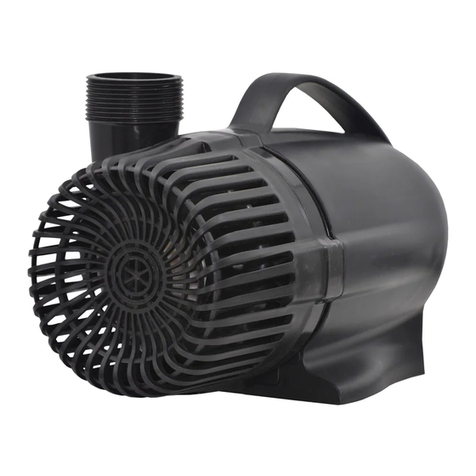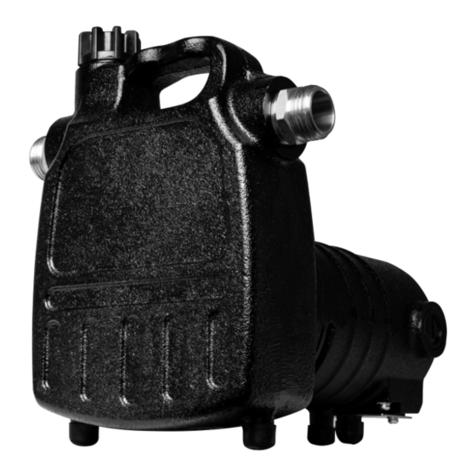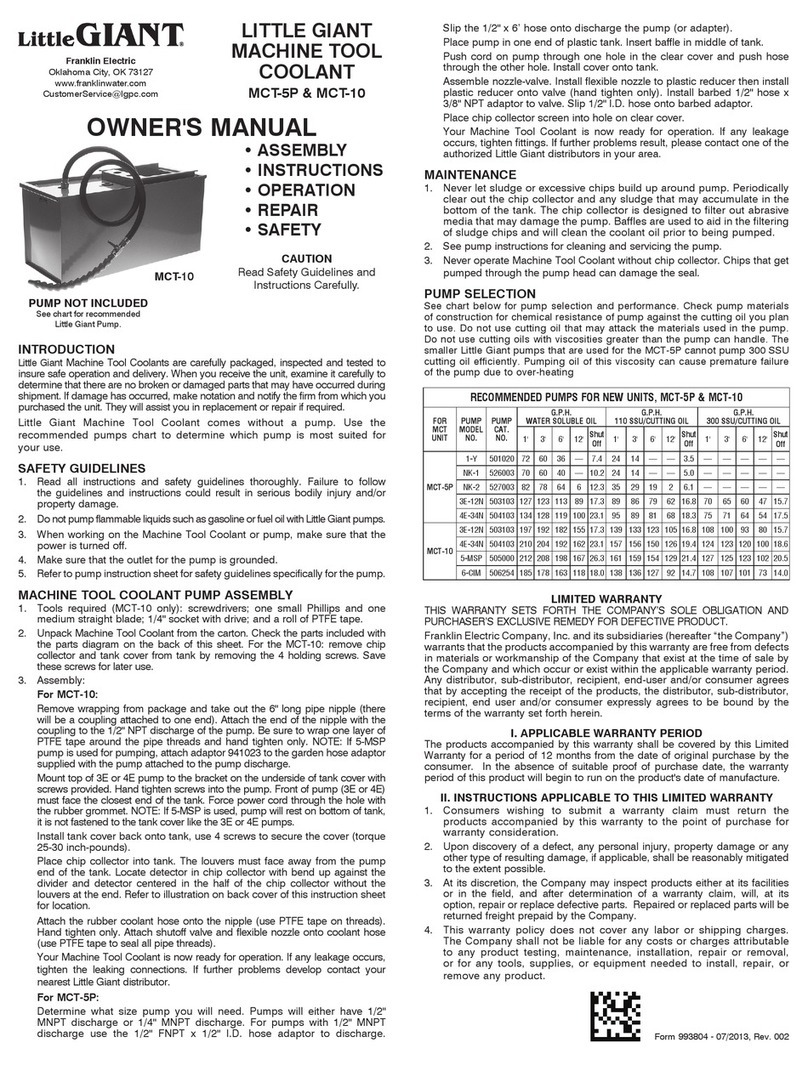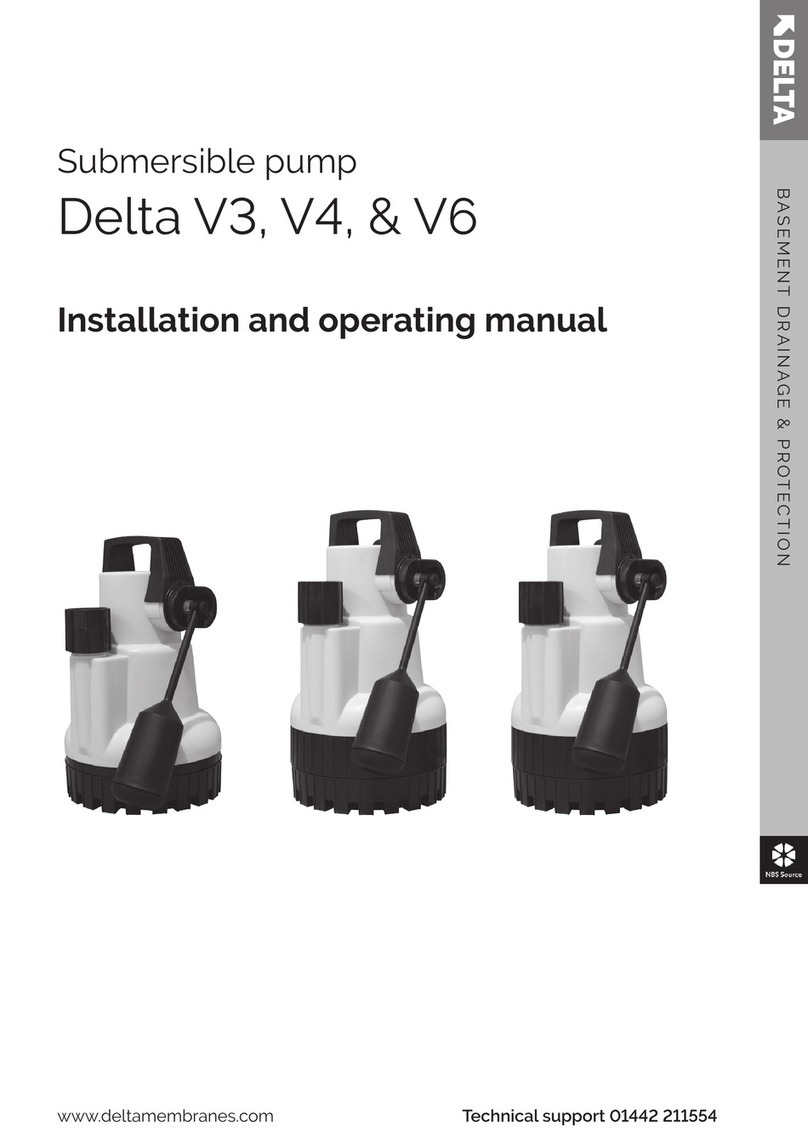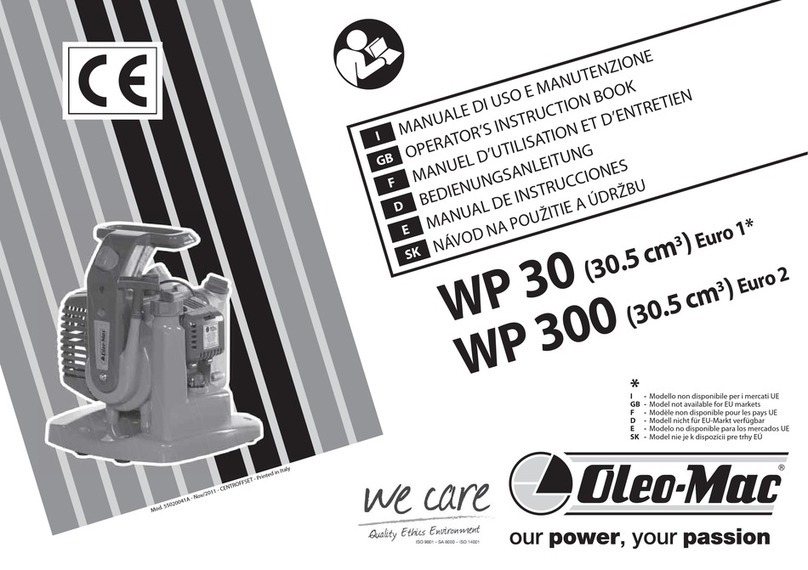FLYGT 3126.290 User manual

Installation, Operation,
and Maintenance Manual
Flygt 3126.290


Table of Contents
Introduction and Safety..................................................................................................................3
Introduction..................................................................................................................................3
Safety.............................................................................................................................................3
Safety terminology and symbols........................................................................................... 3
Environmental safety...............................................................................................................4
User safety................................................................................................................................ 5
Ex-approved products............................................................................................................ 6
Product warranty......................................................................................................................7
Transportation and Storage.......................................................................................................... 8
Inspect the delivery.....................................................................................................................8
Inspect the package................................................................................................................8
Inspect the unit........................................................................................................................ 8
Transportation guidelines.......................................................................................................... 8
Lifting.........................................................................................................................................8
Temperature ranges for transportation, handling and storage............................................ 9
Storage guidelines...................................................................................................................... 9
Product Description......................................................................................................................11
Pump design..............................................................................................................................11
External cooling.........................................................................................................................12
Monitoring equipment............................................................................................................. 13
The data plate............................................................................................................................13
Approvals................................................................................................................................... 14
Product denomination..............................................................................................................15
Installation......................................................................................................................................17
Install the pump.........................................................................................................................17
Install with P-installation....................................................................................................... 18
Install with S-installation....................................................................................................... 19
Install with T-installation....................................................................................................... 19
Make the electrical connections..............................................................................................20
Prepare the SUBCAB™cables..............................................................................................22
Connect the motor cable to the pump...............................................................................23
Connect the motor cable to the starter and monitoring equipment..............................24
Cable charts........................................................................................................................... 25
T-installation: Bleed air before starting pump.......................................................................27
Check the impeller rotation..................................................................................................... 27
Operation.......................................................................................................................................29
Estimate zinc anode replacement intervals........................................................................... 29
Start the pump...........................................................................................................................30
Maintenance..................................................................................................................................31
Torque values............................................................................................................................ 31
Change the oil........................................................................................................................... 32
Service the pump...................................................................................................................... 33
Inspection...............................................................................................................................33
Major overhaul.......................................................................................................................34
Service in case of alarm........................................................................................................ 34
Table of Contents
Flygt 3126.290 Installation, Operation, and Maintenance Manual 1

Replace the impeller.................................................................................................................34
Replace the C- or D-impeller............................................................................................... 35
Install the impeller: C, D....................................................................................................... 36
Install the F-impeller..............................................................................................................37
Troubleshooting........................................................................................................................... 40
The pump does not start..........................................................................................................40
The pump does not stop when a level sensor is used......................................................... 41
The pump starts-stops-starts in rapid sequence...................................................................41
The pump runs but the motor protection trips..................................................................... 41
The pump delivers too little or no water................................................................................42
Technical Reference..................................................................................................................... 44
Table of Contents
2 Flygt 3126.290 Installation, Operation, and Maintenance Manual

Introduction and Safety
Introduction
Purpose of this manual
The purpose of this manual is to provide necessary information for:
• Installation
• Operation
• Maintenance
CAUTION:
Read this manual carefully before installing and using the product. Improper use of the
product can cause personal injury and damage to property, and may void the warranty.
NOTICE:
Save this manual for future reference, and keep it readily available at the location of the
unit.
Safety
WARNING:
• The operator must be aware of safety precautions to prevent physical injury.
• Operating, installing, or maintaining the unit in any way that is not covered in this
manual could cause death, serious personal injury, or damage to the equipment. This
includes any modification to the equipment or use of parts not provided by Xylem. If
there is a question regarding the intended use of the equipment, please contact a
Xylem representative before proceeding.
• Do not change the service application without the approval of an authorized Xylem
representative.
CAUTION:
You must observe the instructions contained in this manual. Failure to do so could result
in physical injury, damage, or delays.
Safety terminology and symbols
About safety messages
It is extremely important that you read, understand, and follow the safety messages and
regulations carefully before handling the product. They are published to help prevent
these hazards:
• Personal accidents and health problems
• Damage to the product
• Product malfunction
Hazard levels
Hazard level Indication
DANGER:
A hazardous situation which, if not avoided, will result in
death or serious injury
Introduction and Safety
Flygt 3126.290 Installation, Operation, and Maintenance Manual 3

Hazard level Indication
WARNING:
A hazardous situation which, if not avoided, could result
in death or serious injury
CAUTION:
A hazardous situation which, if not avoided, could result
in minor or moderate injury
NOTICE:
• A potential situation which, if not avoided, could
result in undesirable conditions
• A practice not related to personal injury
Hazard categories
Hazard categories can either fall under hazard levels or let specific symbols replace the
ordinary hazard level symbols.
Electrical hazards are indicated by the following specific symbol:
Electrical Hazard:
These are examples of other categories that can occur. They fall under the ordinary
hazard levels and may use complementing symbols:
• Crush hazard
• Cutting hazard
• Arc flash hazard
Environmental safety
The work area
Always keep the station clean.
Waste and emissions regulations
Observe these safety regulations regarding waste and emissions:
• Appropriately dispose of all waste.
• Handle and dispose of the processed liquid in compliance with applicable
environmental regulations.
• Clean up all spills in accordance with safety and environmental procedures.
• Report all environmental emissions to the appropriate authorities.
CAUTION: Radiation Hazard
Do NOT send the product to Xylem if it has been exposed to nuclear radiation, unless
Xylem has been informed and appropriate actions have been agreed upon.
Electrical installation
For electrical installation recycling requirements, consult your local electric utility.
Recycling guidelines
Always recycle according to these guidelines:
Introduction and Safety
4 Flygt 3126.290 Installation, Operation, and Maintenance Manual

1. Follow local laws and regulations regarding recycling if the unit or parts are accepted
by an authorized recycling company.
2. If the first guideline is not applicable, then return the unit or parts to your local sales
and service representative.
User safety
General safety rules
These safety rules apply:
• Always keep the work area clean.
• Pay attention to the risks presented by gas and vapors in the work area.
• Avoid all electrical dangers. Pay attention to the risks of electric shock or arc flash
hazards.
• Always bear in mind the risk of drowning, electrical accidents, and burn injuries.
Safety equipment
Use safety equipment according to the company regulations. Use this safety equipment
within the work area:
• Hard hat
• Safety goggles, preferably with side shields
• Protective shoes
• Protective gloves
• Gas mask
• Hearing protection
• First-aid kit
• Safety devices
NOTICE:
Never operate a unit unless safety devices are installed. Also see specific information
about safety devices in other chapters of this manual.
Electrical connections
Electrical connections must be made by certified electricians in compliance with all
international, national, state, and local regulations. For more information about
requirements, see sections dealing specifically with electrical connections.
Hazardous liquids
The product is designed for use in liquids that can be hazardous to your health. Observe
these rules when you work with the product:
• Make sure that all personnel who work with biologically hazardous liquids are
vaccinated against diseases to which they may be exposed.
• Observe strict personal cleanliness.
Wash the skin and eyes
Follow these procedures for chemicals or hazardous fluids that have come into
contact with your eyes or your skin:
Condition Action
Chemicals or hazardous fluids in
eyes 1. Hold your eyelids apart forcibly with your fingers.
2. Rinse the eyes with eyewash or running water for at least 15 minutes.
3. Seek medical attention.
Introduction and Safety
Flygt 3126.290 Installation, Operation, and Maintenance Manual 5

Condition Action
Chemicals or hazardous fluids on
skin 1. Remove contaminated clothing.
2. Wash the skin with soap and water for at least 1 minute.
3. Seek medical attention, if necessary.
Ex-approved products
Follow these special handling instructions if you have an Ex-approved unit.
Personnel requirements
These are the personnel requirements for Ex-approved products in potentially explosive
atmospheres:
• All work on the product must be carried out by certified electricians and Xylem
authorized mechanics. Special rules apply to installations in explosive atmospheres.
• All users must know about the risks of electric current and the chemical and physical
characteristics of the gas, the vapor, or both present in hazardous areas.
• Any maintenance for Ex-approved products must conform to international and
national standards (for example, IEC/EN 60079-17).
Xylem disclaims all responsibility for work done by untrained and unauthorized personnel.
Product and product handling requirements
These are the product and product handling requirements for Ex-approved products in
potentially explosive atmospheres:
• Only use the product in accordance with the approved motor data.
• The Ex-approved product must never run dry during normal operation. Dry running
during service and inspection is only permitted outside the classified area.
• Before you start work on the product, make sure that the product and the control
panel are isolated from the power supply and the control circuit, so they cannot be
energized.
• Do not open the product while it is energized or in an explosive gas atmosphere.
• Make sure that thermal contacts are connected to a protection circuit according to the
approval classification of the product, and that they are in use.
• Intrinsically safe circuits are normally required for the automatic level-control system
by the level regulator if mounted in zone 0.
• The yield stress of fasteners must be in accordance with the approval drawing and the
product specification.
• Do not modify the equipment without approval from an Ex-approved Xylem
representative.
• Only use parts that are provided by an Ex-approved Xylem representative.
• The thermal detectors fitted to the stator windings shall be connected into the motor
control circuit in such a manner as to disconnect the supply to the motor in order to
prevent the Temperature Class T3.
• The width of flameproof joints is more than the values specified in the tables of the
IEC 60079–1 standard.
• The gap of flameproof joints is less than the values specified in Table 1 of the IEC
60079–1 standard.
• The equipment must be submerged during normal operation.
Guidelines for compliance
Compliance is fulfilled only when you operate the unit within its intended use. Do not
change the conditions of the service without the approval of an Ex-approved Xylem
representative. When you install or maintain explosion proof products, always comply
with the directive and applicable standards (for example, IEC/EN 60079–14).
Minimum permitted liquid level
See the dimensional drawings of the product for the minimum permitted liquid level
according to the approval for explosion proof products. If the information is missing on
Introduction and Safety
6 Flygt 3126.290 Installation, Operation, and Maintenance Manual

the dimensional drawing, the product must be fully submerged. Level-sensing equipment
must be installed if the product can be operated at less than the minimum submersion
depth.
Monitoring equipment
For additional safety, use condition-monitoring devices. Condition-monitoring devices
include but are not limited to the following:
• Level indicators
• Temperature detectors
Product warranty
Coverage
Xylem undertakes to remedy defects in products from Xylem under these conditions:
• The faults are due to defects in design, materials, or workmanship.
• The faults are reported to a local sales and service representative within the warranty
period.
• The product is used only under the conditions that are described in this manual.
• The monitoring equipment that is incorporated in the product is correctly connected
and in use.
• All service and repair work that is done by Xylem authorized personnel.
• Genuine Xylem parts are used.
• Only Ex-approved spare parts and accessories that are authorized by an Ex-approved
Xylem representative are used in Ex-approved products.
Limitations
The warranty does not cover defects that are caused by these situations:
•Deficient maintenance
• Improper installation
•Modifications or changes to the product and installation that are made without
consulting a Xylem authorized representative
• Incorrectly executed repair work
• Normal wear and tear
Xylem assumes no liability for these situations:
• Bodily injuries
• Material damages
• Economic losses
Warranty claim
Xylem products are high-quality products with expected reliable operation and long life.
However, should the need for a warranty claim arise, contact your local sales and service
representative.
Spare parts
Xylem guarantees that spare parts will be available for 15 years after the manufacture of
this product has been discontinued.
Introduction and Safety
Flygt 3126.290 Installation, Operation, and Maintenance Manual 7

Transportation and Storage
Inspect the delivery
Inspect the package
1. Inspect the package for damaged or missing items upon delivery.
2. Note any damaged or missing items on the receipt and freight bill.
3. File a claim with the shipping company if anything is out of order.
If the product has been picked up at a distributor, make a claim directly to the
distributor.
Inspect the unit
1. Remove packing materials from the product.
Dispose of all packing materials in accordance with local regulations.
2. Inspect the product to determine if any parts have been damaged or are missing.
3. If applicable, unfasten the product by removing any screws, bolts, or straps.
For your personal safety, be careful when you handle nails and straps.
4. Contact the local sales representative if there is any issue.
Transportation guidelines
Precautions
DANGER: Crush Hazard
Moving parts can entangle or crush. Always disconnect and lock out power before
servicing to prevent unexpected startup. Failure to do so could result in death or serious
injury.
Position and fastening
The unit can be transported either horizontally or vertically. Make sure that the unit is
securely fastened during transportation, and cannot roll or fall over.
Lifting
Always inspect the lifting equipment and tackle before starting any work.
WARNING: Crush Hazard
1) Always lift the unit by its designated lifting points. 2) Use suitable lifting equipment and
ensure that the product is properly harnessed. 3) Wear personal protective equipment. 4)
Stay clear of cables and suspended loads.
NOTICE:
Never lift the unit by its cables or hose.
Lifting equipment
Lifting equipment is always required when handling the unit. It must fulfill the following
requirements:
• The minimum height (contact your local sales and service representative for
information) between the lifting hook and the floor must be sufficient to lift the unit.
• The lifting equipment must be able to hoist the unit straight up and down, preferably
without the need for resetting the lifting hook.
• The lifting equipment must be securely anchored and in good condition.
Transportation and Storage
8 Flygt 3126.290 Installation, Operation, and Maintenance Manual

• The lifting equipment must support the weight of the entire assembly and must only
be used by authorized personnel.
• Two sets of lifting equipment must be used to lift the unit for repair work.
• The lifting equipment must be dimensioned to lift the unit with any remaining
pumped media in it.
• The lifting equipment must not be oversized.
CAUTION: Crush Hazard
Over-dimensioned lifting equipment can lead to injury. A site-specific
risk analysis must be done.
Temperature ranges for transportation, handling and storage
Handling at freezing temperature
At temperatures below freezing, the product and all installation equipment, including the
lifting gear, must be handled with extreme care.
Make sure that the product is warmed up to a temperature above the freezing point
before starting up. Avoid rotating the impeller/propeller by hand at temperatures below
the freezing point. The recommended method to warm the unit up is to submerge it in the
liquid which will be pumped or mixed.
NOTICE:
Never use a naked flame to thaw the unit.
Unit in as-delivered condition
If the unit is still in the condition in which it left the factory - all packing materials are
undisturbed - then the acceptable temperature range during transportation, handling and
storage is: –50°C (–58ºF) to +60°C (+140ºF).
If the unit has been exposed to freezing temperatures, then allow it to reach the ambient
temperature of the sump before operating.
Lifting the unit out of liquid
The unit is normally protected from freezing while operating or immersed in liquid, but
the impeller/propeller and the shaft seal may freeze if the unit is lifted out of the liquid
into a surrounding temperature below freezing.
Units equipped with an internal cooling system are filled with a mixture of water and 30%
glycol. This mixture remains a flowing liquid at temperatures down to –13°C (9°F). Below –
13°C (9°F), the viscosity increases such that the glycol mixture will lose its flow properties.
However, the glycol-water mixture will not solidify completely and thus cannot harm the
product.
Follow these guidelines to avoid freezing damage:
1. Empty all pumped liquid, if applicable.
2. Check all liquids used for lubrication or cooling, both oil and water-glycol mixtures,
for the presence of unacceptable amounts of water. Change if needed.
Storage guidelines
Storage location
The product must be stored in a covered and dry location free from heat, dirt, and
vibrations.
NOTICE:
• Protect the product against humidity, heat sources, and mechanical damage.
• Do not place heavy weights on the packed product.
Transportation and Storage
Flygt 3126.290 Installation, Operation, and Maintenance Manual 9

Long-term storage
If the unit is stored more than six months, then the following apply:
• Before operating the unit after storage, it must be inspected with special attention to
the seals and the cable entry.
• The impeller/propeller must be rotated every other month to prevent the seals from
sticking together.
Transportation and Storage
10 Flygt 3126.290 Installation, Operation, and Maintenance Manual

Product Description
Pump design
The pump is submersible, and driven by an electric motor.
Intended use
The product is intended for moving wastewater, sludge, raw and clean water. Always
follow the limits that are given in Application limits (page 44). If there is a question
regarding the intended use of the equipment, please contact a local sales and service
representative before proceeding.
DANGER: Explosion/Fire Hazard
Special rules apply to installations in explosive or flammable atmospheres. Do not install
the product or any auxiliary equipment in an explosive zone unless it is rated explosion-
proof or intrinsically-safe. If the product is EN/ATEX-, MSHA- or FM-approved, then see
the specific EX information in the Safety chapter before taking any further actions.
NOTICE:
Do NOT use the pump in highly corrosive liquids.
Spare parts
•Modifications to the unit or installation should only be carried out after consulting with
Xylem.
• Original spare parts and accessories that are authorized by Xylem are essential for
compliance. The use of other parts can invalidate any claims for warranty or
compensation. For more information contact your Xylem representative.
Pressure class
MT Medium head
HT High head
Product Description
Flygt 3126.290 Installation, Operation, and Maintenance Manual 11

Parts
WS003611A
2
3
1
4
5
6
7
8
9
Position Denomination Description
1 Shaft The shaft is made of stainless steel, with an integrated rotor.
2 Mechanical seals One inner and one outer seal in a combination of materials:
• Silicon carbide RSiC
• Corrosion-resistant cemented carbide WCCR
For information about the pumps mechanical seals, see Parts List.
3 Monitoring sensor Optional sensor. For information about the sensors, see Optional
sensors (page 13).
4 Oil housing The oil housing includes a coolant that lubricates and cools the seals; the
housing acts as a buffer between the pumped fluid and the drive unit.
5 Impeller There are multiple types of impellers. For information about the pumps
impellers, see Parts List.
6 Main bearing The bearing consisting of a two-row angular contact ball bearing.
7 Motor For information about the motor, see Motor data (page 44).
8 Cooling Cooling without jacket: The pump is cooled by the ambient liquid.
Cooling with jacket: The motor is cooled by the circulation of a portion of the
pumped liquid in the space between the stator housing and the cooling
jacket. The cooling jacket can also be used with an external cooling system.
Fore more information, see External cooling (page 12).
9 Support bearing The bearing consisting of a single-row ball bearing.
External cooling
Requested items
The following items are requested in order to use external cooling:
Product Description
12 Flygt 3126.290 Installation, Operation, and Maintenance Manual

• Cooling jacket
• Solid plugs
• External cooling system (hose, water source, etc.) including hose coupling nipples
with thread R1/4 “
Contact your local Xylem representative for more information.
Parts
WS003622A
2
1
3
1. Plug
2. Sleeve
3. Solid plug
Connection type 1
The external cooling fluid enters through the hole in the stator housing marked “cool in”.
This requires that the plug is replaced by a hose coupling nipple and hose. The fluid exits
at the impeller and the lower seal. For this type of connection, one of the sleeves between
the oil housing and the stator housing must be replaced with a solid plug.
Connection type 2
The external cooling fluid enters through the hole in the stator housing marked “cool in”.
This requires that the plug is replaced by a hose coupling nipple and hose. The fluid exits
through the hole in the stator housing market “cool out”. This requires that the plug is
replaced by a hose coupling nipple and hose. For this type of connection, both of the
sleeves between the oil housing and the stator housing must be replaced with solid plugs.
Monitoring equipment
The following applies to the monitoring equipment of the pump:
• The stator incorporates three thermal contacts connected in series that activate the
alarm and stops the pump at overtemperature
• The thermal contacts open at 125°C (257°F).
• Ex-approved pumps must have thermal contacts connected to the control panel.
• The sensors must be connected to either the MiniCAS II monitoring equipment or an
equivalent equipment.
• The monitoring equipment must be of a design that makes automatic restart
impossible.
• Information in the junction box shows if the pump is equipped with optional sensors.
Optional sensors
FLS FLS is a miniature float switch for detection of liquid in the stator housing. Due to its
design it is best suited for pumps in a vertical position. The FLS sensor is installed in
the bottom of the stator housing.
The data plate
The data plate is a metal label that is located on the main body of the products. The data
plate lists key product specifications. Specially approved products also have an approval
plate.
Product Description
Flygt 3126.290 Installation, Operation, and Maintenance Manual 13

2
1312 14
22
21
20
17 18 1916159 10 11
8
7
6
5
4
31
23
24
WS006257A
1. Curve code or Propeller code
2. Serial number
3. Product number
4. Country of origin
5. Additional information
6. Phase; type of current; frequency
7. Rated voltage
8. Thermal protection
9. Thermal class
10. Rated shaft power
11. International standard
12. Degree of protection
13. Rated current
14. Rated speed
15. Maximum submergence
16. Direction of rotation: L=left, R=right
17. Duty class
18. Duty factor
19. Product weight
20. Locked rotor code letter
21. Power factor
22. Maximum ambient temperature
23. Read installation manual
24. Notified body, only for EN-approved Ex products
Figure 1: The data plate
Approvals
Product approvals for hazardous locations
Pump Approval
3126.290 European Norm (EN)
• ATEX Directive
• EN 60079-0:2009, EN 60079-1:2007, EN 13463-1:2009,
EN 13463-5:2011
•II 2 G c Ex d IIB T4 Gb
EN approval for cable entry:
•Certificate number: INERIS 02ATEX9008 U
•II 2 G Ex d IIC Gb or I M2 Ex d I Mb
IEC
• IECEx scheme
• IEC 60079-0, IEC 60079-1
• Ex d IIB T4
FM (FM Approvals)
• Explosionproof for use in Class I, Div. 1, Group C and D
• Dust ignition proof for use in Class II, Div. 1, Group E, F and
G
• Suitable for use in Class III, Div. 1, Hazardous Locations
Product Description
14 Flygt 3126.290 Installation, Operation, and Maintenance Manual

EN approval plate
This illustration describes the EN approval plate and the information that is contained in
its fields.
1 2 3
4
5
6 7 89 10
12
11
13
14
15
WS003972A
1. Approval
2. Approval authority and
Approval number
3. Approval for Class I
4. Approved for drive unit
5. Stall time
6. Starting current or Rated
current
7. Duty class
8. Duty factor
9. Input power
10. Rated speed
11. Controller
12. Additional information
13. Maximum ambient
temperature
14. Serial number
15. ATEX marking
IEC approval plate
This illustration describes the IEC approval plate and the information that is contained in
its fields.
International Norm; not for EU member countries.
WS001279B
21
876
3
4
5 9
10
11
12
13
1. Approval
2. Approval authority and
Approval number
3. Approved for drive unit
4. Stall time
5. Starting current or Rated
current
6. Duty class
7. Duty factor
8. Input power
9. Rated speed
10. Controller
11. Additional information
12. Maximum ambient
temperature
13. Serial number
FM approval plate
This illustration describes the FM approval plate and the information that is contained in
its fields.
1
2WS003973A
1. Temperature class
2. Maximum ambient
temperature
Product denomination
Reading instruction
In this section, code characters are illustrated accordingly:
Product Description
Flygt 3126.290 Installation, Operation, and Maintenance Manual 15

X = letter
Y = digit
The different types of codes are marked up with a, b and c. Code parameters are marked
up with numbers.
Codes and parameters
XXYYYY YYY YYY YYYY
1234567
a
b
c
WS006265B
.
Type of Callout Number Indication
Type of code a Sales denomination
b Product code
c Serial number
Parameter 1 Hydraulic end
2 Type of installation
3 Sales code
4 Version
5 Production year
6 Production cycle
7 Running number
Product Description
16 Flygt 3126.290 Installation, Operation, and Maintenance Manual

Installation
Install the pump
Before starting work, make sure that the safety instructions in the chapter Introduction and
Safety (page 3) have been read and understood.
DANGER: Electrical Hazard
Before starting work on the unit, make sure that the unit and the control panel are isolated
from the power supply and cannot be energized. This applies to the control circuit as well.
DANGER: Inhalation Hazard
Before entering the work area, make sure that the atmosphere contains sufficient oxygen
and no toxic gases.
Hazardous atmospheres
DANGER: Explosion/Fire Hazard
Special rules apply to installations in explosive or flammable atmospheres. Do not install
the product or any auxiliary equipment in an explosive zone unless it is rated explosion-
proof or intrinsically-safe. If the product is EN/ATEX-, MSHA- or FM-approved, then see
the specific EX information in the Safety chapter before taking any further actions.
WARNING: Explosion/Fire Hazard
Do not install CSA-approved products in locations that are classified as hazardous in the
National Electric Code(TM), ANSI/NFPA 70-2005.
General requirements
These requirements apply:
• Use the pump dimensional drawing in order to ensure proper installation.
• In T-installation, the pump must be equipped with cooling jacket.
Before installing the pump, do the following:
• Provide a suitable barrier around the work area, for example, a guard rail.
• Make sure that equipment is in place so that the unit cannot roll or fall over during the
installation process.
• Check the explosion risk before you weld or use electric hand tools.
• Check that the cable and cable entry have not been damaged during transport.
• Always remove all debris and waste material from the sump, inlet piping, and
discharge connection, before you install the pump.
NOTICE:
• Never force piping to make a connection with a pump.
Authority regulation
Vent the tank of a sewage station in accordance with local plumbing codes.
Fasteners
• Only use fasteners of the proper size and material.
• Replace all corroded fasteners.
• Make sure that all fasteners are properly tightened and that there are no missing
fasteners.
Installation
Flygt 3126.290 Installation, Operation, and Maintenance Manual 17

Install with P-installation
In the P-installation, the pump is installed on a stationary discharge connection, and
operates either completely or partially submerged in the pumped liquid. These
requirements and instructions only apply when the installation is made according to the
dimensional drawing.
WS006259A
Figure 2: P-installation
These items are required:
• Guide bars
• Guide bar bracket for attaching the guide equipment to the access frame or to the
upper part of the sump
• Cable holder for holding the cable
• Access frame (with covers) to which the upper guide bar bracket and cable holder can
be attached
• Discharge connection for connecting the pump to the discharge line
The discharge connection has a flange which fits the pump housing flange and a
bracket for attaching the guide equipment.
• Fasteners for the discharge connection
• Anchor bolts
1. Install the access frame:
a) Place the access frame in position and align it horizontally.
b) Grout the frame in place.
2. Grout the anchor bolts in place.
Be careful when you align and position the discharge connection in relation to the
access frame.
3. Place the discharge connection in position, and tighten the nuts.
4. Install the guide bars:
a) Secure the guide bars in the bracket.
b) Check that the guide bars are placed vertically. Use a level or a plumb line.
5. Connect the discharge pipe to the discharge connection.
6. Lower the pump along the guide bars.
When it reaches the bottom position, the pump automatically connects to the
discharge connection.
7. Secure the motor cable:
Installation
18 Flygt 3126.290 Installation, Operation, and Maintenance Manual
Table of contents
Other FLYGT Water Pump manuals

FLYGT
FLYGT 3202 User manual

FLYGT
FLYGT Flygt 3069 User manual
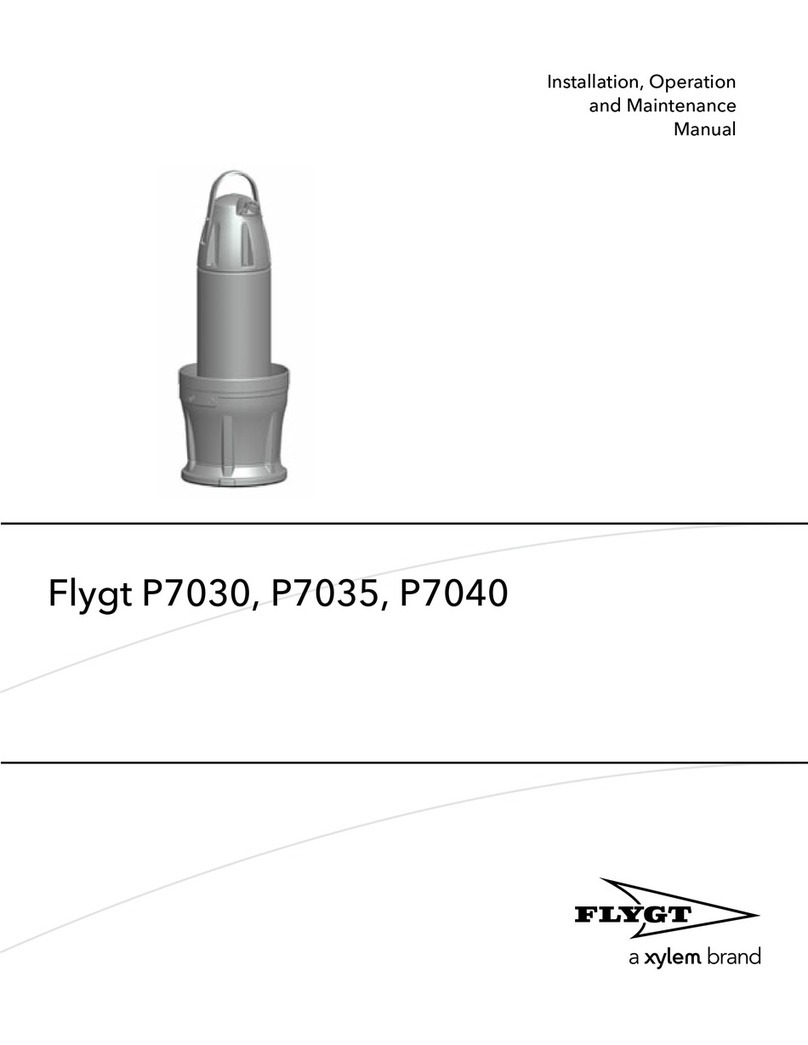
FLYGT
FLYGT P7030 User manual

FLYGT
FLYGT 3153 User manual

FLYGT
FLYGT 3085 Installation and operating instructions

FLYGT
FLYGT DX Series User manual
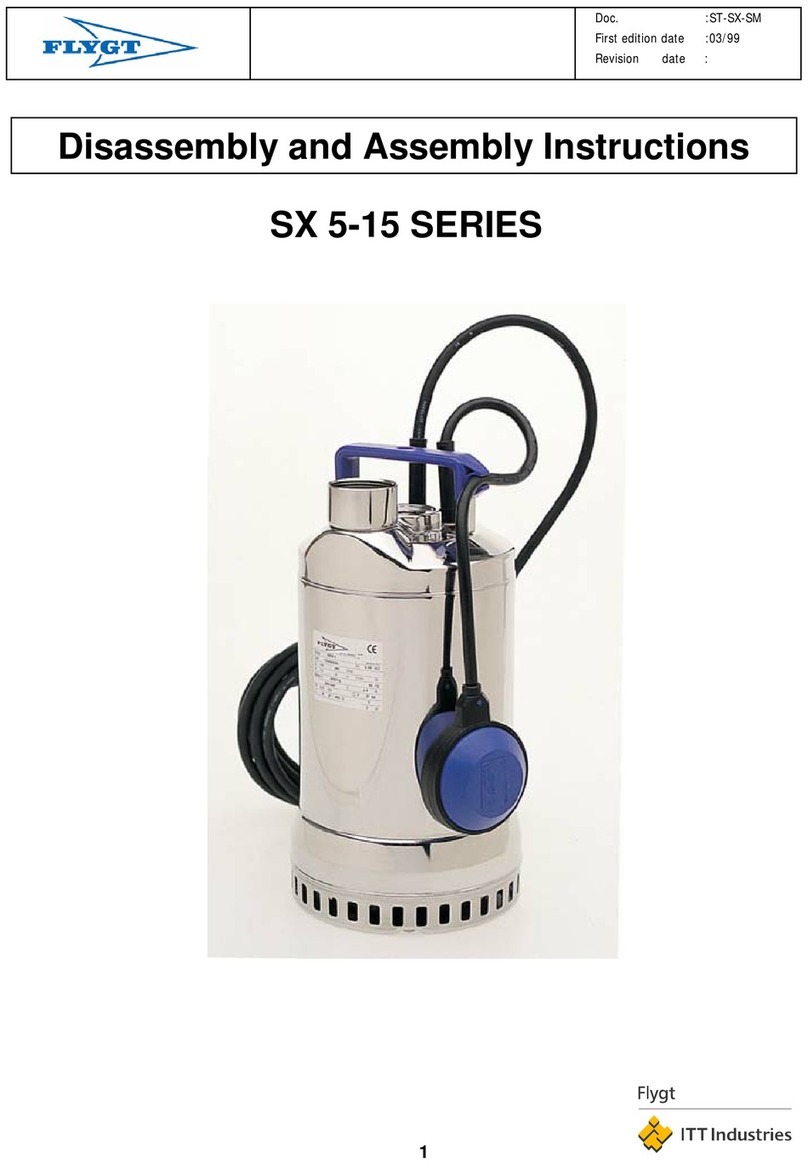
FLYGT
FLYGT SX 5-15 Series User manual

FLYGT
FLYGT 2125 User manual

FLYGT
FLYGT MP-3067 User manual

FLYGT
FLYGT ITT Flygt Series User manual
Popular Water Pump manuals by other brands
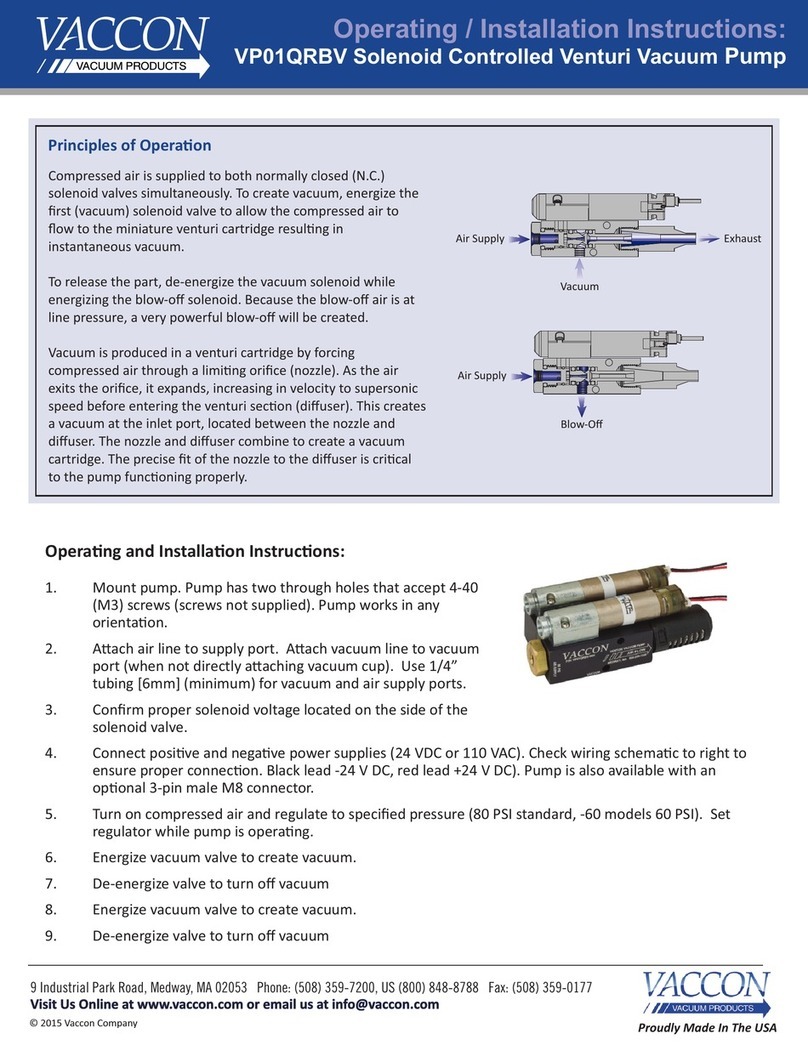
Vaccon
Vaccon VP01QRBV Operating & installation instructions

Little Giant
Little Giant Simply Falls owner's manual

Little Giant
Little Giant 4-MD-SC manual

Aqua One
Aqua One CAP Series instruction manual

Little Giant
Little Giant VCMA-20-PRO Series quick start guide
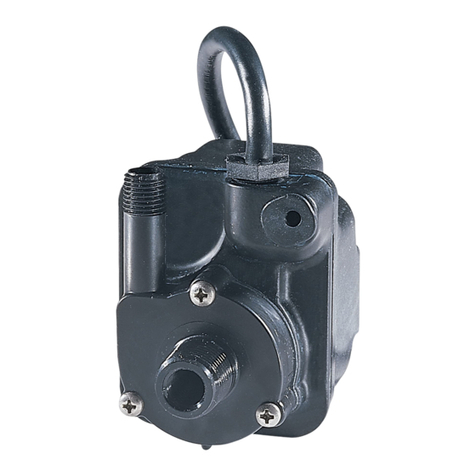
Little Giant
Little Giant 1-EA Series quick start guide

